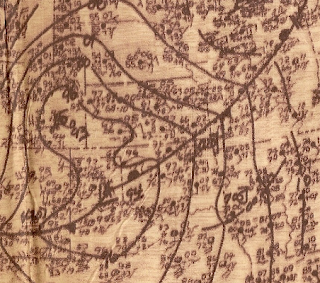Attention: Managers in the Field of Weather Forecasting
[If you aren't interested in some of the "inside baseball" aspects of
weather forecasting, please skip this posting.]
 |
| Surface Chart from a 1974 Tornado Outbreak, I did hand analysis on it, which is why I kept it. |
Two items from the last seven days highlight this issue facing weather science.
- My superior heavy rain forecast earlier this week. I cite this forecast not to brag but to illustrate my point. The NWS forecast of the heavy rain is below. It was too far south. To compare the accuracy of the two, go here. Plotting surface charts that morning demonstrated the models (often favored by young meteorologists) had the crucial front, which would anchor the rain in one area, too far south. Please note that, at the time, I cited "non-model techniques," among them the hand analysis as the reasons for the differing forecast. This was a vital example as severe flooding resulted.

- An article in the Palm Beach Post indicating the NWS's National Hurricane Center is going to cut back on hand analysis. Why? This year, the hurricane center will hand plot only hurricanes that could affect land — a break from decades of tradition but a compromise for younger forecasters more comfortable with computers and less inclined to spend time with colored pencils and compasses. “It’s a bit of a generational gap,” Brennan said. “There are some people who probably would like to get rid of the paper map entirely, and some who would like to use it all the time.”
To the people currently managing meteorologists, two questions:
- How comfortable would you be with a physician, who during a medical crisis, didn't use the very best techniques because he or she was "uncomfortable" with them?
- During an especially high traffic period with thunderstorms over northern Illinois, would you want to be a passenger on a plane if a Chicago air traffic controller was not using the best techniques because he or she was "uncomfortable" or "inexperienced" with them?
During periods of extreme flash floods and rapidly developing, violent tornadoes as we have had the last ten days, lives depend on meteorologists using the very best techniques so as to produce the best results. Just as the we expect doctors and air traffic control to do their very best to preserve our lives, the public should expect nothing less of us.
While I am now retired, I assure you that I dealt with this, over and over, when working with young meteorologists. The root problem is most colleges teaching meteorology do not emphasize hand analysis even though it is vital. In fact, most of the people teaching students to forecast have never done forecasting for a career (i.e., the reason they got their paycheck).
Supervising meteorologists in a way that maximizes the creation -- every time -- of the most accurate and timely forecasts and warnings is what managerial meteorologists are paid to do. I agree teaching and holding your team members accountable can be exhausting and it certainly doesn't make you popular. But, that is why you are a manager.
If we want to reverse the unfortunate accuracy trends in some aspects of severe storm forecasts and warnings, we have to do a better job of teaching, coaching and guiding. And, holding people accountable for providing the best forecasts and warnings in a timely manner.





Comments
Post a Comment